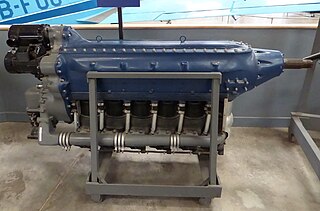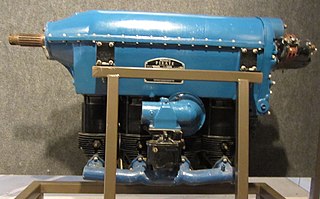
Aerospace is a term used to collectively refer to the atmosphere and outer space. Aerospace activity is very diverse, with a multitude of commercial, industrial, and military applications. Aerospace engineering consists of aeronautics and astronautics. Aerospace organizations research, design, manufacture, operate, or maintain both aircraft and spacecraft.

The Glenn L. Martin Company, also known as The Martin Company from 1917 to 1961, was an American aircraft and aerospace manufacturing company founded by aviation pioneer Glenn L. Martin. The Martin Company produced many important aircraft for the defense of the US and allies, especially during World War II and the Cold War. During the 1950s and '60s, the Martin Company moved from the aircraft industry into the guided missile, space exploration, and space utilization industries.

Hirth Engines GmbH is an engine manufacturer based in Benningen, Germany. It is currently a part of the UMS Aero Group. Hirth began manufacturing aero engines in the 1920s, was taken over by Heinkel in WWII to develop the Heinkel-Hirth jet engines, and today specialises in small two-stroke engines for light aircraft and other applications.

The Goodrich Corporation, formerly the B.F. Goodrich Company, was an American manufacturing company based in Charlotte, North Carolina. Founded in Akron, Ohio in 1870 as Goodrich, Tew & Co. by Dr. Benjamin Franklin Goodrich, the company name was changed to the "B.F. Goodrich Company" in 1880, to BFGoodrich in the 1980s, and to "Goodrich Corporation" in 2001. Originally a rubber manufacturing company known for automobile tires, the company diversified its manufacturing businesses throughout the twentieth century and sold off its tire business in 1986 to focus on its other businesses, such as aerospace and chemical manufacturing. The BFGoodrich brand name continues to be used by Michelin, who acquired the tire manufacturing business in 1988. Following the acquisition by United Technologies in 2012, Goodrich became a part of UTC Aerospace Systems.

Hamilton Standard was an American aircraft propeller parts supplier. It was formed in 1929 when United Aircraft and Transport Corporation consolidated Hamilton Aero Manufacturing and Standard Steel Propeller into the Hamilton Standard Propeller Corporation. Other members of United Aircraft included Boeing, United Airlines, Sikorsky and Pratt & Whitney. At the time, Hamilton was the largest manufacturer of aircraft propellers in the world.
The Cirrus and Hermes or Cirrus-Hermes are a series of British aero engines manufactured, under various changes of ownership, from the 1920s until the 1950s. The engines were all air-cooled, four-cylinder inline types, with earlier ones upright and later designs inverted.
Nadcap is a global cooperative accreditation program for aerospace engineering, defense and related industries.

The de Havilland Gipsy is a British air-cooled four-cylinder in-line aircraft engine designed by Frank Halford in 1927 to replace the ADC Cirrus in the de Havilland DH.60 Moth light biplane. Initially developed as an upright 5 litre capacity engine, later versions were designed to run inverted with increased capacity and power.

The Menasco Buccaneer was a series of popular six-cylinder, air-cooled, in-line, inverted, aero-engines, that were manufactured by Menasco Motors Company for light general aviation and sport aircraft during the 1930s and 1940s.

The Menasco Pirate series were four-cylinder, air-cooled, in-line, inverted aero-engines, built by the Menasco Motors Company of Burbank, California, for use in light general and sport aircraft during the 1930s and 1940s. The Menasco engines came in both normally aspirated and supercharged forms, with the supercharged models exhibiting superior performance at higher altitudes, with a relatively small increase in dimensions and weight. The supercharged models had the S suffix added to their designation to show supercharging.
Kawasaki Heavy Industries Aerospace Company is the aerospace division of Kawasaki Heavy Industries (KHI). It produces aircraft, space systems, simulators, jet engines, missiles, and electronic equipment.

The Napier Javelin was a British six-cylinder inline air-cooled engine designed by Frank Halford and built by D. Napier & Son. First flown in March 1934 in the prototype of the Percival Mew Gull racing aircraft, the engine was also used in the Spartan Arrow biplane and the Percival Gull.

The Menasco Unitwin 2-544 was a coupled piston engine. Menasco Motors Company of Burbank, California was a well known manufacturer of inverted inline four and six cylinder engines. At the request of Lockheed Aircraft designers, Menasco produced an inverted twelve-cylinder air cooled aircraft engine by designing a common crankcase and gearbox for two of the six cylinder engines. The two crankshafts were combined with a unique double clutch gearbox to power a single propeller. This gave reliability of a twin engine aircraft in a single powerplant. It was a success, but did not enter production as no aircraft were produced that used it.
Hamilton Sundstrand was an American globally active corporation that manufactured and supported aerospace and industrial products for worldwide markets. A subsidiary of United Technologies Corporation, it was headquartered in Windsor Locks, Connecticut. The company was formed from the merger of Hamilton Standard and Sundstrand Corporation in 1999. In 2012, Hamilton Sundstrand was merged with Goodrich Corporation to form UTC Aerospace Systems. In 2018, UTC Aerospace Systems and Rockwell Collins combined to form Collins Aerospace.

The Waterman Arrowbile was a tailless, two-seat, single-engine, pusher configuration roadable aircraft built in the US in the late 1930s. One of the first of its kind, it flew safely but generated little customer interest, and only five were produced.
The American Gyro AG-4 Crusader is a small twin engine aircraft. The aircraft was designed as the Shelton Flying Wing in 1933 by Thomas Miles Shelton.

United States Air Force Plant 42 is a classified aircraft manufacturing plant owned by the United States Air Force in the Antelope Valley, about 60 miles from downtown Los Angeles. It is also used by the National Aeronautics and Space Administration (NASA).

The Isotta Fraschini Beta was an air cooled aircraft engine produced by the Italian engineering company Isotta Fraschini in the 1940s. Isotta Fraschini derived the Beta inverted 6-cylinder in-line aircraft engine from the V-12 Gamma. The engine saw limited production for aircraft, including the Nardi FN.316 and Ambrosini SAI.7, but was generally unsatisfactory in service.

The Vega Model 2 Starliner was a prototype five-seat feeder airliner produced by the Vega Airplane Company, a subsidiary of Lockheed. It was designed to be powered by an unusual powerplant, consisting of two Menasco piston engines coupled together to drive a single propeller. A single example was built, flying in 1939, but no production followed.

The Ogden Osprey was a three engine, high wing monoplane airliner which seated six. Designed in the United States and first flown in the spring of 1930 or earlier, six were built and some used commercially before Ogden Aeronautical ceased trading in the Great Depression.


















